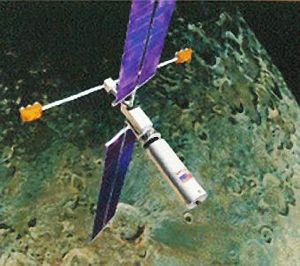
Home - Search - Browse - Alphabetic Index: 0- 1- 2- 3- 4- 5- 6- 7- 8- 9
A- B- C- D- E- F- G- H- I- J- K- L- M- N- O- P- Q- R- S- T- U- V- W- X- Y- Z
SEP Tug
 SEP Tug Credit: © Mark Wade |
Status: Study 1986.
Each 4.5m diameter, 15m long cargo module would be delivered to low lunar orbit by the SEP tug and then land on the lunar surface using a small built-in descent rocket. After the base had been completed, the fleet of SEP ferry vehicles would continue transporting supplies, crew consumables and equipment. Four vehicles operating simultaneously could deliver a 20,000-kilogram payload to low lunar orbit every 100 days.
The reusable 7,700 kg (dry mass) ion-propelled lunar ferry would deliver a 20 metric ton payload to a 100 km lunar orbit and return under its own power to a 300 km low Earth orbit. Only 7.3 metric tons of xenon propellant plus a new set of engines (1.8 t) would be required per flight. The drawback was the total flight time of one year (the system would be used primarily for unmanned logistics support) but the payload fraction would be very high -- 60 %. This was because of the extremely high specific impulse (4,500 s) of the engines, reducing the required spacecraft mass in low Earth orbit (and hence launch costs) by 50% compared with a Shuttle-derived HLLV.
Power for ten engines of 1 N thrust each was generated by two giant 12 x 61 meter solar arrays each producing 150 KW of power. Aston claimed solar electric propulsion was more economical than nuclear power as long as the required power output was less than about 1000 KW. But the solar arrays would have to be very thin (10-25 microns), highly efficient and relatively insensitive to radiation as the passage through the Van Allen belts easily could reduce power output by more than a factor of two after only one round trip to the Moon. Advanced radiation-resistant cell materials might solve the problems, though.
Space Shuttles would attach moonbase habitation modules to the SEP ferries for delivery to the moonbase site. Each lunar ferry mission required only one Shuttle flight for deployment in low Earth orbit. The shuttle also delivered new ion engines and xenon propellant tanks for the solar electric propulsion system. Unlike chemical space tugs, the SEP servicing could be conveniently and safely done from the International Space Station.
S.E.P. Lunar Ferry Mass and Performance Summary
- Lunar Ferry Vehicle Initial Mass (includes Moonbase Module and all Propellant) 35 000 Kg
- Moonbase Cargo Module (including Descent Engine + Landing Propellant) 20 000 Kg
- Xenon Propellant consumed by ion engines 7 300 kg
- S.E.P. Lunar Ferry Dry Mass (Less Cargo) 7 700 kg
- Low Earth Orbit (Leo) Parking Altitude 300 km
- Low Lunar Orbit (Llo) Parking Altitude 100 km
- Total Trip Time (Leo-Llo-Leo) 370 days
- Solar Array Power To Ion Engines 300 kW
- Solar Array Power Density 0.2 kW/m2
- Solar Array Specific Mass (Beginning Of Life - End Of Life) 5 To 6 kg / kW
- Total Ion System Efficiency 0.75
- Ion Engine Specific Impulse 4500s
- Ion Engine Specific Mass 6 kg / kW
- Number of Ion Engines (including spares) 12
Family: Space Tugs. Country: USA.
Back to top of page
Home - Search - Browse - Alphabetic Index: 0- 1- 2- 3- 4- 5- 6- 7- 8- 9
A- B- C- D- E- F- G- H- I- J- K- L- M- N- O- P- Q- R- S- T- U- V- W- X- Y- Z
© 1997-2019 Mark Wade - Contact
© / Conditions for Use